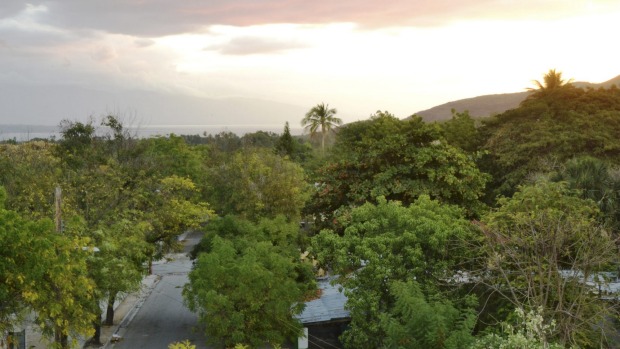
I've never liked the idea of bucket-list travel. Why make another to-do list when faced with your own mortality?
But there is one trip I've wanted to make since so far back I can't remember when I first became fascinated by the idea: travelling down the border that separates my homeland, the Dominican Republic, from its neighbour, Haiti, which shares the island of Hispaniola.
Sharing might not be the best description of the often troubled relationship between the two nations. The island was originally a colony of Spain, until the western half was ceded to France as a consequence of Continental wars in the 18th century. After its independence from France, Haiti occupied the whole island until 1844. Tellingly, it is this date, not that of their secession from Spain, that Dominicans celebrate as their national independence day.
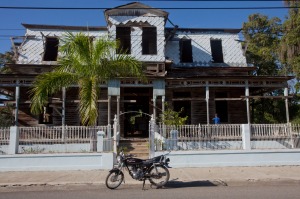
During my childhood under the dictatorship of Rafael Trujillo, the "Dominicanisation" of border areas became a national campaign. Incentives were offered to anyone willing to homestead in our version of the American Wild West.
A 1929 treaty delineated where one country ended and the other began. This was news to some Haitians and Dominicans who suddenly found themselves on the wrong side of the border. Those who disregarded the treaty paid dearly eight years later, when Trujillo, furious over the violation of national sovereignty, ordered the massacre of thousands of Haitians still living on Dominican soil.
This was before my time, but as a child in the '50s, whenever I misbehaved, I was threatened with El Cuco, the Haitian bogeyman. It was said El Cuco would take me away to Haiti where I would become somebody's meal. All of this only served to whet my appetite about the mysterious "other" country next door.
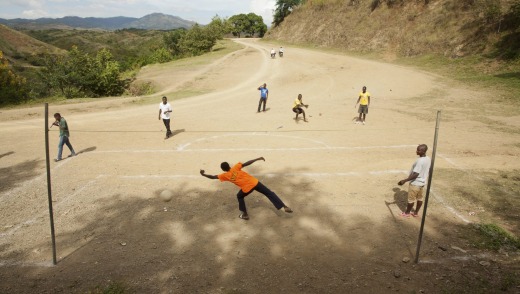
What finally propelled me to undertake the journey was a controversial ruling in the fall of 2013 by the highest court in the land. Dominicans who could not prove their parents' legal status at the time of their birth – retroactive to 1929 – were no longer considered citizens. This denationalisation affected more than 200,000 Dominicans of Haitian descent. There was talk of erecting a wall, militarising the border. I might never be able to make the trip if the xenophobes won the day.
And so, on a sunny morning in February, my husband Bill and I set out in a four-wheel-drive pickup on a journey from Monte Cristi in the north-west, to Pedernales at the southernmost tip of the border. It was only 555 kilometres, but we allowed five days, given the primitive roads, the meagre or non-existent services, and all the unexpected things you encounter in parts unknown without the benefit of an Anthony Bourdain road crew.
We were sticking to Dominican soil, to avoid the endless red-tape permits required to drive into Haitian territory. Midway, however, we'd be straddling the very border on the International Highway, a bone-rattling, 46-kilometre road, begun in 1936 and finished in 1946. In one of the few light moments during this rough stretch, Bill turned to me in the passenger seat. "Hey! I'm in the DR, and you're in Haiti!"
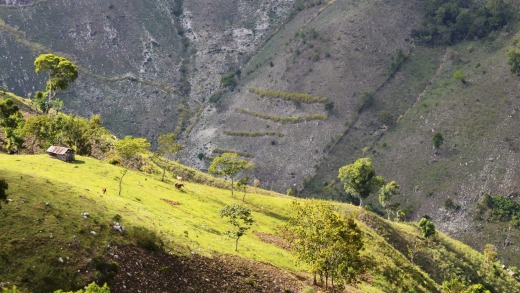
We spent our first day touring Monte Cristi, with its prosperous 19th-century Victorian houses, built when the town was so rich "we could tie up our dogs with sausage links", as one old-timer noted. It was the largest port in the country a century ago, when its exports of mahogany, cedar and campeche dye for fabrics were in much demand in Europe. But with the world wars of the last century, and the Trujillo dictatorship centralising control in the capital, Monte Cristi declined. A certain slant of light, a nostalgic feel in the air, a once-upon-a-time beauty in black widow's garb and white bun gazing out from the top half of a Dutch door, and I could almost believe I'd gone back 100 years to the solitude of Gabriel García Marquez's Macondo.
In Monte Cristi, we also entered a circle of hell. One of our objectives was to visit a Haitian prisoner named Johnny Rivas, arrested on unverified charges of having murdered a witch. We learned of him through some human rights activists who had involved us in a campaign to free him. Although he was arrested before the ruling, his case was yet another example of the frequent violation of the civil rights of Haitians, especially poor ones, on Dominican soil.
Inside San Fernando Fortaleza, we entered another country altogether, run by prisoners with fees for protection and anything else you might want (a prostitute, a cellphone). Our "guardian", a shirtless, chunky guy sporting a Hello Kitty charm on a chain, led us down a dark, airless passageway. Inside the 2.2 square metre cubicle we found a gaunt, haunted Johnny, who had been held without bail for more than nine months. What to say to a man in these circumstances? We listened, more compelled than ever to travel to the strip of land where two nations meet and begin to distance themselves from each other.
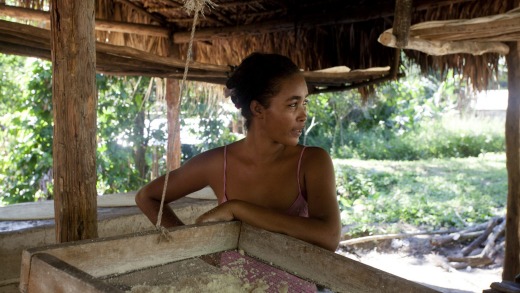
Early the next morning, we headed for Dajabon, on the border, with Ouanaminthe on the Haitian side. Both have become boom towns, with a steady stream of merchants and consumers, Haitians and Dominicans, flowing back and forth on the bridge over the Massacre River. As its name suggests, this border river has historically flowed with blood – not this peaceable, lucrative commerce, which the ruling threatens to dam up.
About 19 kilometres south, Loma de Cabrera charmed us with its dollhouse casitas, many with stands in front, laden with artisan products: milk fudge wrapped in palm husks and filled with guava, orange or cashew fruit; casabe, made in the old way of the Tainos, the indigenous people who lived on the island when the Spaniards arrived. Nestled in the green radiance of the Cordillera Central mountains, the bustling town exuded the diligence of people who only have to look west at the brown, deforested mountains of Haiti to know that they must care for the land.
At the central square we met up with our friend Amadeo, who had agreed to travel with us as our photographer and guide. An agronomist by training, Amadeo is what my mother used to call a todologo, someone who knows about everything – luckily for us, everything Dominican.
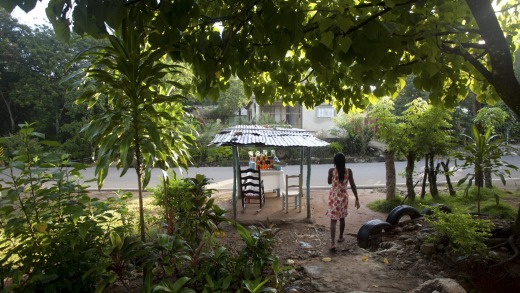
At Restauracion, we picked up the permit required to travel the International Highway. While my companeros waited for the paperwork from a guardia who could barely write, I stepped outside. A man in pressed jeans came running across the street, carting a large, framed reproduction of a Paris street with the Eiffel Tower in the background. When I quizzed him, he had no idea where this scene was, but guessed Nueva York. All week he travels through border towns, renting and selling such decoraciones.
As we started down the highway, the contrast between the two countries was like that between makeover photos – which side represented before and which after depending on your optimism, or lack thereof. To our left, the Dominican side was greener, the houses grouped into settlements (Villa Anacaona, Los Algodones, Guayajayuco) with a church, a school and a park. Between the villages were occasional military posts, manned by one or two bored guards in ragamuffin clothes – flip-flops, a soiled ski cap, a T-shirt from Marshall University medical school ("Sorry. Can't. Gotta Study"). They brandished guns as we approached but readily put them aside to chat.
On the Haitian side, the houses were made of mud or crude wooden boards scrabbled together. The only apparent businesses were a gallera; a houngan's hut with its telltale flags; a repair shop, Repuestos de Diego, the name in Spanish, but the list of services in Kreyol. Outside another house hung a poster of the Mirabal sisters, who fought against the dictatorship. Haitians honouring our Dominican heroines! But the owner had no idea who these pretty women were – just a free adornment he didn't have to purchase from an itinerant art dealer, like the Marlboro ad beside it.
But past Guayajayuco, we encountered desolation on both sides: barren mountainsides, no houses, no people, not even an occasional mango or ceiba (the two trees Haitians will spare: one gives fruit, the other is sacred). The only indication of a border were the alternating "mojones", markers inscribed "1929, RD" or "RH" (Republica Dominicana or Republique d'Haiti), although one of the latter had been altered to 1829, as if to prove Haiti was here first.
As we descended into the fertile San Juan Valley, we felt like Noah stepping out of his ark. The signs of civilisation greeted us: tiny casitas, a boy on a bicycle, a small bodega with cold Presidente beers, and a smouldering trash heap. At the Artibonite River, the official end of the International Highway, we turned in our permit and headed for the night's destination, Las Matas de Farfan.
Amadeo, whose routes were often dictated by whatever culinary delight the area was known for, insisted our first stop be Domingo's shop to taste his famous Arish cheese. A tangy wafer made with cow or goat milk and coated in oregano, it was brought to the country by los Arabes, part of an influx of immigrants Trujillo imported to populate the border.
Amadeo had booked us rooms at a hotel with a sign proclaiming "under new management". But D'Cactus turned out to have the same old problems besetting small establishments in out-of-the-way places (inconsistent electricity, no hot water, sometimes no water at all, and plenty of scary bugs, including a tarantula in the bathroom). The lobby was hung with wall-to-wall paintings: European cityscapes, Greek temples, still lifes with candles, goblets or flasks of wine. (Had the itinerant art dealer been through town?) A young artist was painting over one canvas. He had been hired to replace the classical scenes with local landscapes. Perhaps the new management was on the right track, after all.
We checked in to our hotel hurriedly in order to make it to San Juan de la Maguana, just north of town, before dark. There, we visited Corral de los Indios, a clearing, ringed with stones, where the Tainos once held their rituals. We walked into the sacred circle, no cordon keeping us out. This is a country where you can still touch history and, judging from the missing stones, even carry a piece of it away.
Legend has it Taina chieftain Anacaona used to relax on a boulder at the centre after a long day. She was the sister and wife of two Caciques who ruled different regions of Ayiti, as the whole island was known back then. To this day, Anacaona is revered on both sides of the border, an icon of solidarity. I sat on her rock, summoning her noble spirit to descend on her squabbling children.
On Saturday morning, before leaving Las Matas, we visited its famed mercado. This was not a Dajabon type of border market, with brokers dealing in everything from disposable diapers to cellphone chargers, but a true farmer's market, offering tamarinds and unroasted coffee beans spilling out of sacks. Of course, it's a small (globalised) world: hanging beside braids of garlic was a SpongeBob SquarePants beach towel.
It was early, and the breakfast stands were busy, especially one specialising in yaniqueques, a Dominican version of johnnycakes, brought over by migrants from the British Antilles, known as Cocolos, who came to work on the sugar plantations. Arish cheese and yaniqueques and quipes (from Lebanese immigrants' kibbe): the eclectic cuisine reflects an island culture where the inhabitants are sponges, absorbing whatever comes in, including – even if some refuse to acknowledge it – what comes across the border, only miles away.
That was where we were headed, south-west to Hondo Valle, where the road hugged the border before it turned inland into the Sierra de Neiba, the mountainous cloud forest we would cross to the border town of Jimani. According to Amadeo, yesterday's roads were a piece of cake compared with what awaited us.
As if his words suddenly became manifest, a man flagged us down and thrust a paper plate with a clump of yellow cake through the window. "Eat, eat!" he encouraged us. Our fearless gourmand, Amadeo, popped a piece in his mouth and exclaimed, "Chenchen!" – a kind of coarse polenta made with milk, and a staple of the south-western part of the country.
The man beckoned. We followed him up a hill to where a large gathering sat around a limoncillo tree, eating chenchen, goat stew, tayotas, and rice and beans. This was the last day of prayers for Maximo, who'd died nine days ago. "He took care of everyone," our host explained. "If he had three, he gave you two." I looked around at the brown faces, all decidedly Dominican. Because the ruling was on my mind, I wondered if "everyone" included Haitians.
We soon experienced the Haitian counterpart of this generosity. As we left the houses behind, the road climbed, narrowed, then disappeared altogether. To go forward, the pickup would have to cross over gaping holes between boulders. Amadeo was apologetic; he had heard that the road was bad, not impassable.
A dozen Haitian men appeared, trotting uphill, carting rocks to wedge inside the holes. When we successfully cleared the harrowing stretch, they climbed in back, and at the next bad patch, they set to work again. Our very own road crew! Finally, the ground smoothed out. We tipped them, knowing we couldn't really pay for such kindness, only pass it on.
Now that the worst was over, we took in the intense cloud forest surrounding us: towering trees arched above, branches dripping with Spanish moss, studded with bromeliads; huge ferns brushed the sides of the pickup, like tongues licking it clean. As a reader, I love meeting a landscape I've encountered before only in literature. Longfellow's lines ran through my mind: "This is the forest primeval". It was a bucket-list travel moment: I'm glad I've lived to see this!
As we descended into the valley, Lago Enriquillo came into view, the largest saltwater lake and the lowest elevation in the Antilles. (Another bragging point: the Dominican Republic also has the highest peak, Pico Duarte, at 3098 metres.) The lake is home to migratory birds, crocodiles, flamingoes and iguanas. But as we got closer, an apocalyptic scene came into view: flooded farmlands; tree trunks rotting in murky water; a small town, Boca de Cachon, submerged. Bucket-list moments can go in reverse: I wished I hadn't lived to see this.
This entry into Jimani didn't lessen the unsavoury impression we left with the next morning.
Now the major crossing in the south, Jimani was once a poor border town much like the ones we passed on the International Highway. But in the 1930s and '40s, it became the target of Trujillo's Dominicanisation frenzy, "civilised into a bastion of the spirit of a new Dominican era", to quote a fawning article of the time.
Today Jimani still has that pumped-up quality, with none of the layered history of its counterpart, Dajabon, the major crossing in the north. Port-au-Prince is only an hour west and Santo Domingo three hours south-east, both on good roads, so Jimani serves as the port of entry and exit of many a politico needing to make a quick getaway.
But I'm breaking the cardinal rule of border travel: don't take sides. And so, I should tell you that after the 2010 earthquake in Haiti, Jimani became the centre of aid: medicines, doctors and supplies flowed in; customs and immigration restrictions were lifted; the 40-bed hospital swelled to 400. The Pan American Health Organization declared it "the capital of Dominican-Haitian solidarity".
If we had fulfilled to the letter my lifelong wish of travelling the length of the border, we would have headed straight south from Jimani to that last pairing of sister towns, Pedernales and Anse-a-Pitre. But to do so we would have to traverse another sierra, Bahoruco, on a remote road whose condition Amadeo's contact hadn't gotten back to him about. It's also a major area for smuggling, not primarily drugs, as I imagined. According to Amadeo, 30 per cent of the Haitian coffee crop comes into the Dominican Republic as contraband along this corridor. We decided not to risk it. After all, bucket-list travel should be something fun you do before you die, not something you might die doing.
So we took the longer, safer route, down the east coast of the Bahoruco Peninsula to our last stop, Pedernales. Most of the peninsula is a national park, a reserve for endemic species, including more than 150 species of birds. At Bahia de las Aguilas, we met a group of the birders, led by Rockjumper, a touring company for birding adventures. Two older gentlemen, who looked like extras for a movie about the British Raj (khaki-colored short pants, knee socks, safari hats, sunburned faces), hurried down a hill to announce that they'd spotted a flock of Caribbean martins. This had the effect of a fire alarm in a high school lunchroom: everyone made for the exit. Except for one Rockjumper who stayed behind enjoying something else she wouldn't get midwinter in Wisconsin: fresh conch cooked in a criollo sauce.
Pedernales, like Jimani, was also a town that received the steroids of Trujillo's Dominicanisation crusade. Inhabitants were lured with promises of land, jobs, weekly subsidies (10¢ a head for each child). But unlike Jimani, Pedernales was too remote to become an important border crossing. Instead, it has maintained a sweet, untampered quality, as if it remembers its roots as a fishing village, and its grander pre-Columbian history as part of Jaragua, the largest of the five caciquajes into which the island was then divided. Its name, in fact, means flint, from the local stone the Tainos shaped into cutting utensils and arrows. A few years back, when Alcoa pulled out of its nearby bauxite operations, Pedernales went into a steep decline; the lightweights left, and those who stayed mined a deeper, richer resource: a vast expanse of unspoiled nature. With that discovery came a fierce sense of stewardship.
Perhaps because of this larger perspective – nature over nationality – Pedernales' relations with its neighbour seemed less fraught. On Monday morning, we headed for the market, crossing a footbridge into Anse-a-Pitre, with only our word at the border trailer that we'd be right back. No fees, red tape, endless lines or avoiding all of the above with a bribe.
We spent our last day exploring the Sierra de Bahoruco on the questionable road we had avoided when we came into town. Midday, the smugglers were surely having their siestas. As we climbed toward the village of Aguas Negras, we watched the landscape turn from semi-arid to forest, cactuses giving way to trumpet flowers and flourishing poinsettia hedges that didn't seem related to their puny, potted cousins up north. The central square exhibited the harmonious pairings evident everywhere we had travelled: cars passing plows pulled by oxen; modern art being delivered to a casita with dirt floors; and, here, a Dominican teenager on a bench texting on her cellphone, while a few feet away, sitting on upturned buckets, two Haitian girls in smocks braiding each other's hair.
This, too: Dominicans and Haitians, coexisting peaceably.
The New York Times